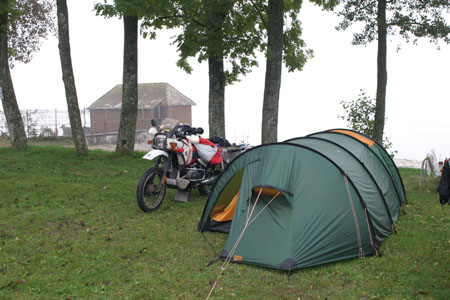
This is a listing of the major pieces of camping equipment which we have and those which we have had to discard or replace along the way. We are, by the way, not sponsored or otherwise supported by any of the manufacturers, and these are simply the things we have found which work best for us. No endorsement of any product should be assumed or is implied.

(Here is a picture taken on our first day on the road. Only the main 6 stakes are being used. For more pictures of the tent in action check out camping spots)
Ok, I loved our "old" tent, see Archive section, but after almost 10 years faithful duty (three of which it was used daily), it was time to replace it. All the material was getting pretty tattered, and rips where showing up in a number of places. At first I tried contacting Moss, thinking that it might be possible to save it, unfortunately they did not respond to my queries. Then I started to look at the current models around, and came across Hilleberg, a high quality tent manufacturer based in Sweden. Of their tents, the one most suited for our trip was the Keron, and as we wanted even more room than our last tent, we went with the 4GT which is pretty much the Mount Everest of tents (they just don't get any bigger.).
We purchased the tent as well as their footprints (mid and front), and proceeded to test it out. On the second trip, on a windy night in Munich a tent pole snapped. This was replaced very quickly by Transa Lucerne where I bought it. I am still not sure why it snapped, as it was not that windy. As an insurance measure, I purchased heavier weight poles from Hilleberg (at a costs equal to a high quality tent from other manufacturers.). Guess what, one of these poles went. One of the end pieces broke because the connecting pole did not go deep enough in the sleeve, a manufacturing error. Again this was replaced very quickly, but sorely tested my faith in Hilleberg, although to be fair they do not manufacture the poles.
Three years on, and around 50 test nights before the trip, and now (at the time of writing) two months daily use I am absolutely convinced that the choice was correct. The tent is roomy, it goes up in a New York minute. It goes up with 4 stakes at a minimum (for normal use it takes 6 stakes), if it is windy (and it has been very windy on a number of occasions), it is possible to stake it down with an additional 8 stakes, (these can be reduced by cross staking to 5 stakes, cross staking is what I call using a single stake for multiple guidelines). In a hurricane it can be staked down even further with an additional 8 stakes. Anybody still counting? If all stake possibilities are utilized you will need 22 stakes. Something which I have yet to try.
One of my favorite features of the tent is that the front apses is large enough to cook in, and if required it can be enlarged by moving the sleeping space back. Check out their site and a complete description of the features, you will be impressed.
Regarding the footprints, I decided to go ahead with the manufacturers version rather than cheaper ones, simply because I wanted to see if they are worth the money. I must (reluctantly) say yes, they are better quality, fit perfectly and pack very small. In the end much better than a couple of other I tried with it.
In all, an excellent tent, end of story.
Ok, we have now been on the road nearly 6 months, and I thought I would update this.
I am still happy with the tent, it is very sturdy and easy to put up.
We have had a few problems with the stakes though, on one occasion two stakes broke in two days!
The first, was a "standard" rip, usually when the pole is flexed too much, high wind usually being the culprit.
The second, was a case where through vibration the insert moved, until it no longer had enough area covered in the opposite side and caused it to rip. This was the second time I had such a break. The picture above is how the pole(s) looked when I took them out. The insert was totally loose in the sleeve!
In total we have had three broken poles in 6 months, not exactly a very comforting situation. We informed Transa and asked if they had heard of other people with similar problems, or if they have hear about problems with the DAC 9.8mm OD 3600mm tent poles. The answer was no and no (they also contacted Hilleberg). They provided a number of suggestions, most of which I already followed, e.g.. take wind direction into account, don't just throw the poles down in order to assemble, loosen the lines and poles during the day (the tent material will shrink considerably during the day, and go out at night) etc. The one suggestion that they made that I had not previously done (at least not often), was to "always" stake the tent out completely, even if there is no wind. So now I am always staking the tent out completely (all the guidelines are down). I assume that this will ensure that the pole are always supported to a certain extent by the guide lines. So far so good.
For good measure, I asked for, and received from Transa 4 replacement poles. So now I don't worry too much, 4 stakes as replacement is pretty much over the top.
The next problem which reared its head recently is the zippers. The problem has been that the main zipper which is used to go in and out of the tent no longer closed properly. We experienced similar problems with out previous tent, but only after 2 years heavy usage! In this case, I lubricated the zippers well, and that helped. At least for a while. After a month it started again. This time, I very carefully, using a pair of needle nose pliers closed the back part of the slider. That fixed the problem, for how long is anyone's guess. I will update this as soon as I find out!
In case anyone is wondering, yes, I am still happy with the tent. These "problems" are annoying but not really that tragic, considering the use and abuse we put this and in fact all out equipment, we are willing to take a lot into account. The people at Transa have been very supportive, and by extension the manufacturer, so we are satisfied.
- After contacting Hilleberg, they provided me with a replacement set of Zippers, so now I am all set.
- An additional pole broke same problems as previously, after a couple of e-mails with Hilleberg, we agreed that it is a problem with the poles. It doesn't show up very much, so there isn't much that can be done. I will continue to replace the pole if it happens again.
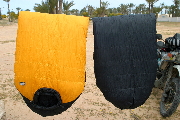
These sleeping bags are supposed to be good down to -15°C, we have only made it to around -2°C, and they are nice and warm. The problem we have had with the bags, is that they get very wet on the outside. The inside is dry, so perspiration is pulled through to the outside, this together with the condensation which forms inside the tent, causes the bags to be pretty wet on the outside. The material seem to literally wick the moisture in. That a certain amount moisture is present is normal, but for us the problem starts when we move everyday and have to compress the bag daily. The result is that the down also starts getting wet, and starts clumping, and thereby loosing their insulation abilities. We have informed the manufactures/retailer (Transa), after much debate and discussion they have informed us that the "best" they can do is give us new bags at cost. In other words we have to buy new bags, something which we are not willing to do just yet. In defense of the bags, they might be fine for some uses where there is not such a high moisture/humid environment as we have been exposed to, and they can be thoroughly dried before putting away. The problem shows up most often when the temperatures drop below 5°C.
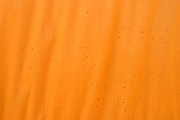
After 6 months and some very cool/cold nights, and plenty of humidity. The situations continues. The bags HAVE to be aired everyday otherwise they start to get moldy. So we are getting very religious about this, pretty impractical some days but it has to be. Now that we are heading into warm territory, the moisture build up from condensation is minimal to nonexistent, what remains, is normal respiration/perspiration, which collects on the outside of the bag, mostly around the head area. The bags now have some black spots from mould. Something which I don't think we will be able to get rid of. C' est la Vie.

As a concession to our "old" age we have decided to go with the full length mats, rather than the 3/4 lengths we had previously. These mats we have now been using for around 6 years and are very happy with them. The advantage is that we don't have to separately insulate the last 1/4 of the body. Ok, I am 190cm and my feet still stick out at the end, but I will live. Previously we were putting our clothes down at that end!
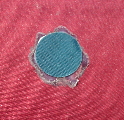
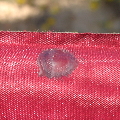
Unlike our previous mats which we still have and used over a 7 year period, my matt has had to be fixed twice already! Two small punctures, both of which I fixed in Tunisia. The first I used the standard fix kit from Therma-Rest which consist of a patch and a Hot Bond compound which you heat up and then apply to the hole. Worked as advertised.
The second puncture, I just used some urethane glue (which remains pliable), and that solved the problem.
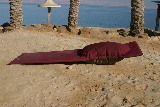
After owning these mats a number of years, we were very surprised to find that one had gotten pregnant (and we didn't even know that we had a male and female Therma-Rest!). We aren't really sure why this suddenly happened, but we surmise that maybe due to the heat in the tent (over 45°C) in Aqaba the matt may have gotten over pressurized? The effect made it self noticed very quickly while using them as "chairs" on Amman Beach at the Dead Sea. Suddenly a strange noise came from the mattress and when I took it out this was what I saw. For the picture I over-inflated the mattress to make the effect noticeable.
In Irbid, Cecilia got on the internet and contacted Therma-Rest support, they answered inside of an hour and are sending us a replacement mattress, without us even having to send the damaged mattress in. Incredible, this is the way customer service should be. Thanks Therma-Rest!
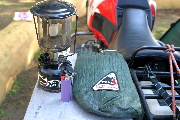
Another great Coleman product. This used to be the smallest gas lantern I had ever seen, unfortunately progress has caught up with it, as there are now smaller lights, nevertheless I am still taking it with me. See Archives for the full text. Suffice it to say it still proves it can take the punishment day after day. The key to using and carrying this little gem, is that you have to have enough mantels. The lamp is tough, but the vibration tents to knock off the mantel. We don't use the lantern every day, and we have found that in general the mantel will last quite a while even with the vibration.

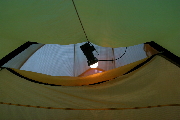
We all know that one should never, ever have anything hot inside a tent. I am referring to candles or any type of lamp which uses an open naked flame. The solution of course is an electric light source. The Chala lamp is a true marvel. It takes 4 rechargeable batteries, has two bulbs, re-charges batteries, and connects to the BMW accessory socket. When the lamp is running from internal batteries only one bulb is used, allowing for a long battery life. When connected to the bike both bulbs burn giving off ample light to read or work on the bike in the middle of the night. It draws so little power that you can have it on continuously for days without draining the bike battery. The battery charger senses when the batteries are charged and stops charging them. I have friends who put halogen bulbs in and use these outside instead of a lantern. The downside to this lamp, and it is a major downside is the price. It is very expensive. For this trip we went ahead and purchased a new one, mainly because Touratech would not sell me a separate cable for my old lamp. The cable has had to be repaired a number of times, and the plastic battery pack is broken (still works fine though).
Having some kind of flashlight is always important. We have
come to depend on our Petzl lamps frequently. They are unique in that they are
"miners" lights, that is they are worn on the head, leaving the hands
free to do other meaningful chores, and this model uses a small thread, keeping
the size to a minimum. They are water resistant and very sturdy and using 3
led diodes which put out a lot of light for such a small light.
The mini-mag are in a class by themselves. Super strong and sturdy, light, compact,
bright light and water resistant. We each carry one in our jackets for those
emergencies where you need to shed some light on the subject.
| Navigate to: | ||||
All Material is ©2010 by Khim Rojas and Fernweh Adventures